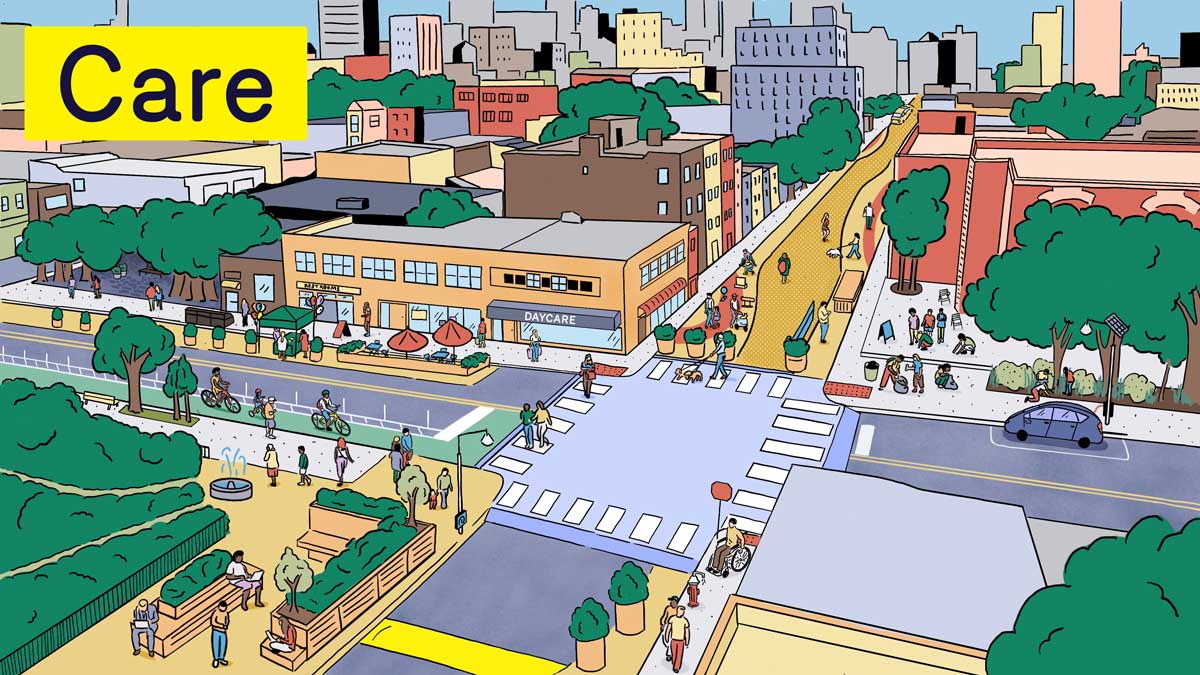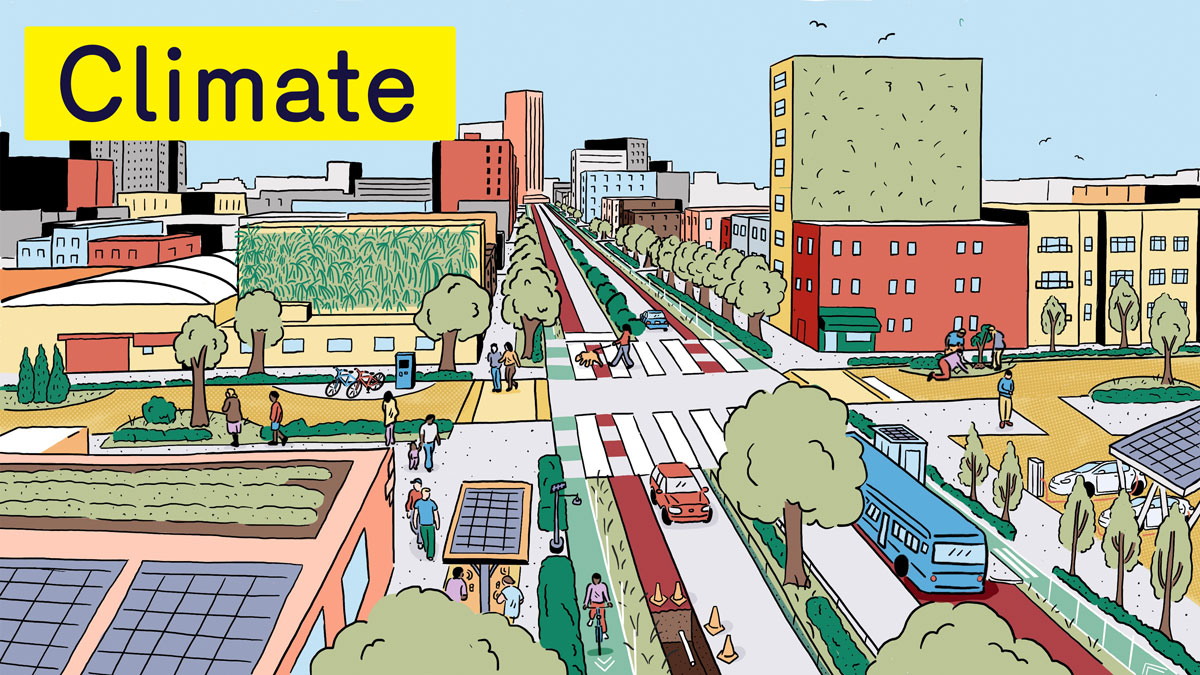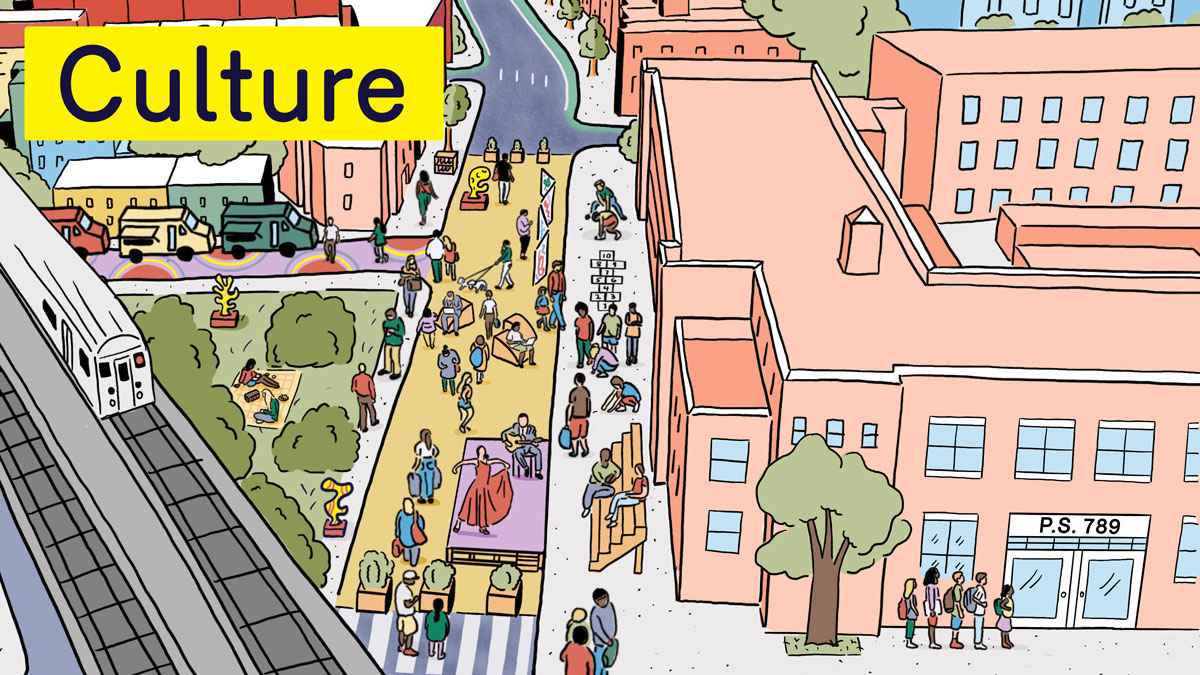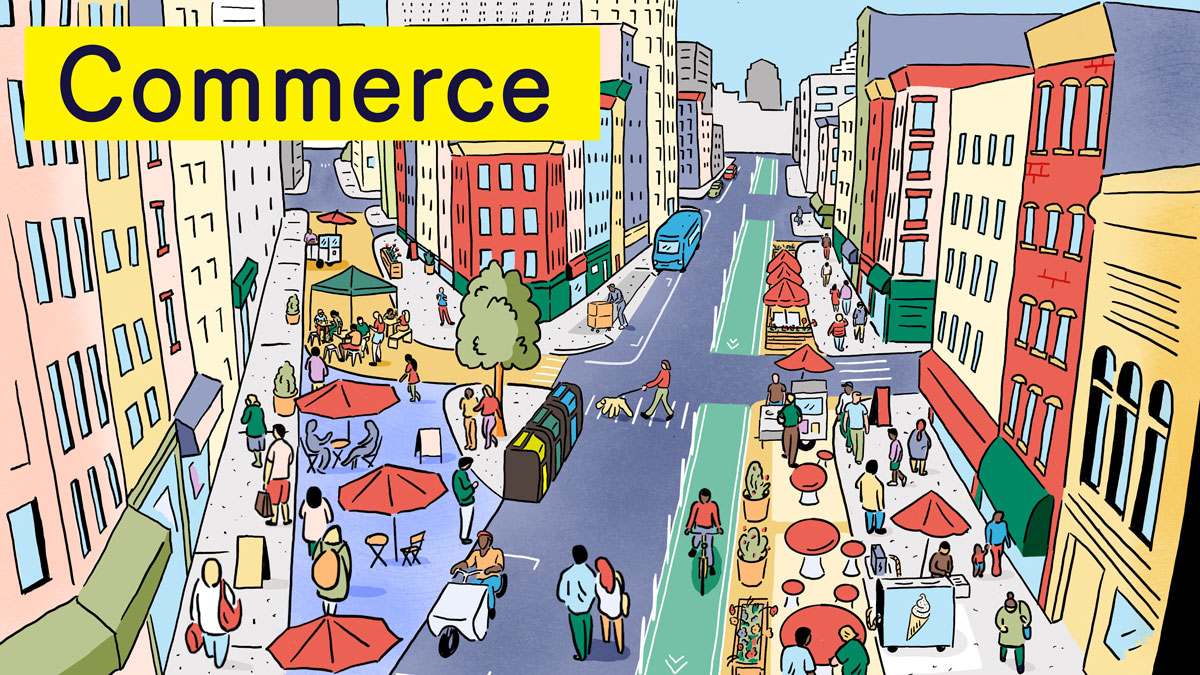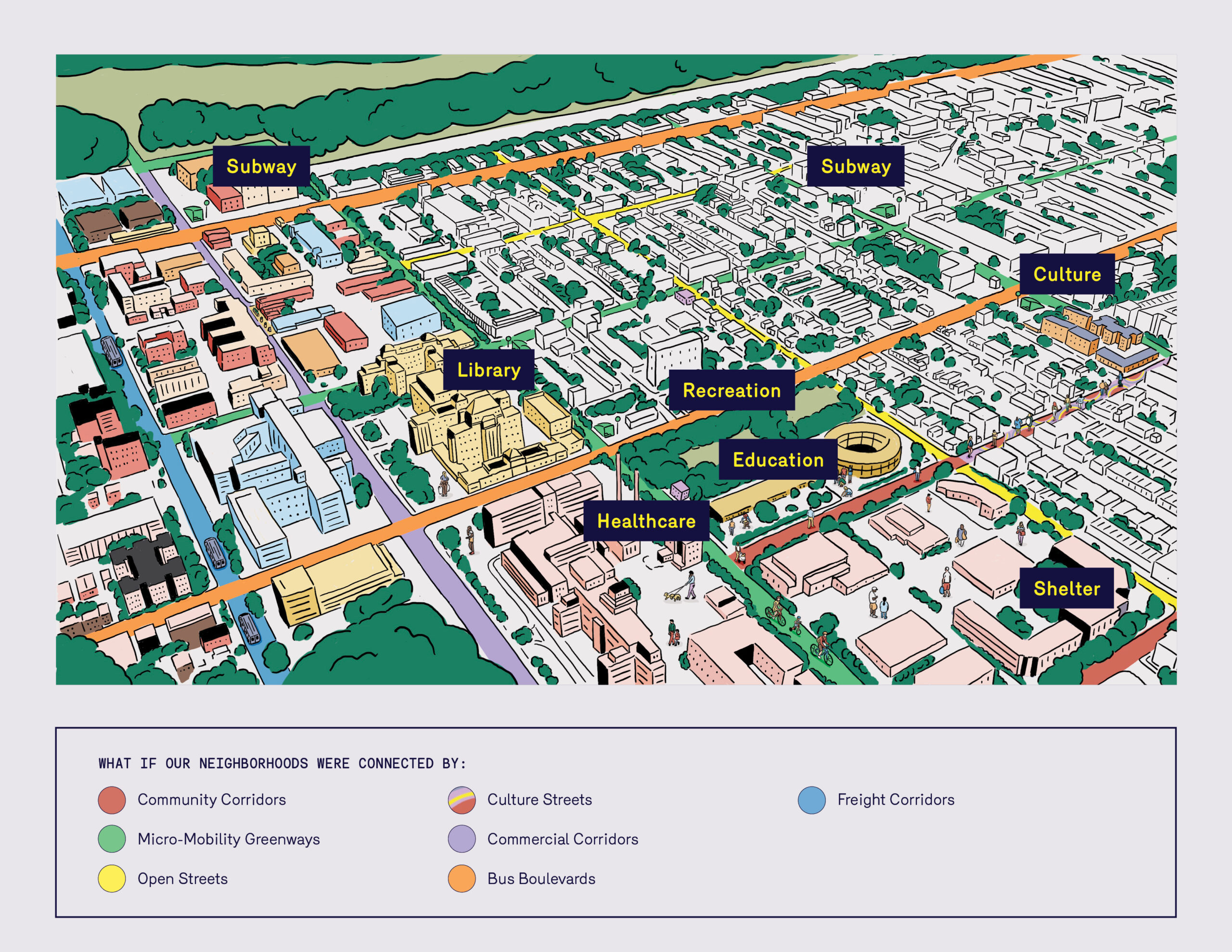
The Vision
Over the past two years, the breadth of new types of street activations has been astounding. Roads that were primarily built for cars became classrooms, restaurants, yoga studios, and community gathering spaces. In many cases, these new uses emerged on the city grid without rhyme or reason; Open Streets could begin and end suddenly, often leaving pedestrians or bicyclists stranded on a busy traffic corridor.
The maintenance and programming of Open Streets also emerged by ability, leaving neighborhoods with fewer resources less equipped to manage their new public spaces. Now, two years later, the City has the opportunity to move from response to a formal integration of the design, governance, usage, and maintenance of transformed streets, while planning for new additions in a holistic way.
Our vision for Continuity in our streets is one that plans for integrated street networks as part of the neighborhood fabric. Streets should be context appropriate, while connecting New Yorkers to key resources like public transportation and shared services. Streets can serve specific purposes that maximize their public benefit, while allowing flexibility for community-determined priorities. We have an opportunity to plan our streets, buildings, public spaces, and transportation comprehensively.
Recommendations
1. Create a Mayor’s Office of the Public Realm.
With many stakeholders in city government managing aspects of the public realm, priorities can often become competing instead of complementary. Drawing on recommendations by the Municipal Art Society for A Public Champion for the Public Realm, the City could establish an Office of the Public Realm within the Mayor’s Office with the power to coordinate and mandate cooperation between city agencies and local elected officials with respect to city streets and other aspects of the public realm. The Office could house local Public Space Managers to understand site- and neighborhood-specific local challenges and improve connected networks of public space.
ACT NOW: Appoint a Chief Public Realm Officer.
By 2023, the Mayor could appoint a Chief Public Realm Officer, who can steward the Interagency Public Realm Working Group launched in Rebuild, Renew, Reinvent. Reporting to the Deputy Mayor of Operations, this position could coordinate with DOT, DSNY, DPR, and DDC. The Chief Public Realm Officer could also ensure coordination with the Deputy Mayor for Economic and Workforce Development and the Deputy Mayor for Strategic Initiatives and their offices (including DCP, DCLA, the Mayor’s Office of Media and Entertainment, the Public Design Commission, SBS, the Office of Civic Engagement, the Public Engagement Unit, and others).
2. Develop a unified framework of street usage to guide future changes.
Building off of previous efforts like the recent Regional Plan Association study Re-Envisioning the Right of Way that defines categories of streets based on use, density, transportation access, distance to public space, or schools, the Office of the Public Realm should develop a unified framework for street usage and design. This framework could be used for prioritizing expansion of the Open Streets network, Bike Boulevards, and future DOT initiatives.
ACT NOW: Map current street categories.
Building on the approved NYC Streets Plan, The Office of the Public Realm, working closely with DOT and other relevant city agencies, should begin creating a unified framework by mapping new street categories to better understand existing use.
3. Build a new network of Community Corridors.
Under the unified framework, the City should define civic and public uses as the nodes of the network that guide the framework. Schools, hospitals, libraries, parks, plazas, and civic buildings would be the focus of Community Corridors, creating a new network of pedestrian-oriented streets. These could be modeled after multi-street Open Streets, such as 34th Street in Queens, which connects schools and residential areas.
ACT NOW: Define a Community Corridor in every borough.
By 2023, The Office of the Public Realm should work with community stakeholders to define a target site for a Community Corridor in all five boroughs.
4. Build a holistic platform for community input on streets.
Communities need to have more opportunities to have a stronger voice in the changes of their streets. By 2030, The City could build on platforms like Participate.nyc to uplift grassroots efforts and empower communities to have a voice in changes to their streets.
Using the platform, which could include street-level detailed map capabilities, and would build on the StreetsPlan MetroQuest Survey, communities would have the ability to propose changes to their streets, or to weigh in on changes to streets proposed by DOT or other entities in a practical and constructive way. The platform could also include a toolbox, including a wide range of feasible design interventions as inspiration for communities to imagine what is possible.
As a whole, the platform would be a way for communities to propose changes and garner support – both political and operational – and for city agencies to fold hyperlocal knowledge and ideas into their thinking. Enacted by liaisons in each district from the Office of the Public Realm, the platform would help community groups such as block associations, civic groups, and arts organizations engage in conversations with the City.
ACT NOW: Convene a community input platform task force.
By 2023, the Interagency Public Realm Working Group should convene a task force, including members of the DOT Street Ambassadors program, to design an initial outreach strategy for a community input platform.
5. Advance a data-driven approach to streets.
Although New York City has innovated in open source data collection, such as with Comp Stat and Crash Stat, it does not collect consistent data on public life.
By 2030, the City should use data and metrics on street use as a design tool for new infrastructure investments. DOT, in partnership with the Office of the Public Realm, should establish an ongoing system of data collection and visualization to understand how people use and experience the public realm, and define successes and failures in street interventions. The database should be public, and include qualitative and socioeconomic data to ensure equitable investments and planning.
ACT NOW: Partner with BIDs that are collecting data.
By 2023, the Interagency Public Realm Working Group should pair BIDs already collecting public life data with civic groups or block associations to share tools and knowledge on robust data collection processes.
6. Develop a holistic public space management framework.
By 2030, the Office of the Public Realm could institutionalize a public space management framework that incorporates long-term, citywide visioning and dedicated funding for public space management to ensure it is equitably distributed across the city. The Office of the Public Realm could lead the strategy to ensure cross-neighborhood and cross-agency uniformity and coordination in managing and overseeing street and plaza maintenance and activity.
ACT NOW: Study challenges for competing uses on the street.
By 2023, the Office of the Deputy Mayor of Operations, in partnership with the Interagency Public Realm Working Group, should begin to develop a public space management framework to determine the key challenges and competing needs on the street.
7. Institutionalize a street and public realm maintenance & engagement corps.
A robust public realm maintenance and engagement corps could boost our economic recovery and provide jobs to New Yorkers, while helping new open spaces like Open Streets and public plazas thrive through cleaning and robust programming.
By 2030, the Office of the Public Realm could partner with NYC Service to build a network of corps members that act as both maintenance workers and engagement stewards. The City should continue to partner with the Horticultural Society and BIDs, and expand the program by learning from initiatives like Uptown Grand Central’s partnership with Positive Workforce on successful local workforce development strategies.
ACT NOW: Marshall the City Cleanup Corps to less-resourced neighborhoods.
In 2023, the City should expand on the City Cleanup Corps to support the cleaning and maintenance of streets and public spaces, starting with Summer Street Stewards deployed at every Open Street in the warmer months. The City should support less-resourced BIDs (with budgets under $500k), and mobilize the program to fill the gaps for areas not covered by BIDs.
8. Invest in and connect to public transportation.
Investment in public transportation is critical to the success of street transformation. In order to ease traffic congestion and reliance on cars, we must invest substantially in fast and far-reaching bus service, expanded bike and scooter share, and regional scale transportation reform.
ACT NOW: Connect transformed streets to public transportation.
Streets free of car traffic have the potential to serve as connectors between alternate modes of transportation. In 2023, DOT could partner with the Metropolitan Transportation Authority (MTA) to establish a plan to network stations and bus networks with streetscape improvements such as bike storage, pedestrian avenues and bike ways to maximize their impact.
9. Harness federal investment for street improvements.
Funds from the Federal Infrastructure and Jobs Act Bill could be used to invest in safety infrastructure on NYC streets that also serve goals for Commerce, Culture, Climate, and Care.
10. Use creative funding strategies like congestion pricing to reinvest in streets.
To combat New York City’s aging infrastructure, the City should leverage initiatives like congestion pricing, toll roads, City-run parking garages, paid parking, and curb space fees to reinvest into streetscape improvements that support a more accessible public realm.
ACT NOW: Add street improvement to congestion pricing legislation. In 2023, the City could advocate for investments in street improvement in congestion pricing legislation.
